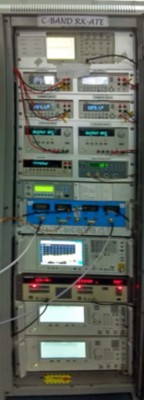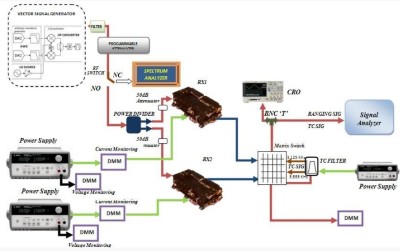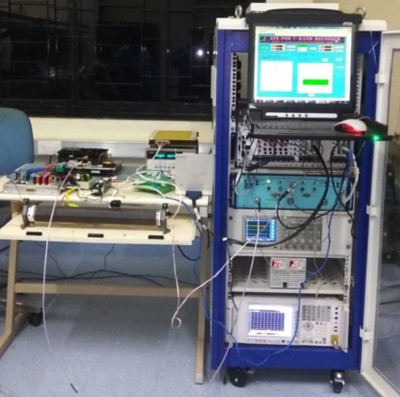URSC, ISRO Improves Flexibility and Scalability of a Satellite TTC Receiver ATE While Reducing Test Times by More Than 50 Percent
Smruti Ranjan Panigrahi, Indian Space Research Organization
"The VIs for the ATE meet the performance and accuracy requirements of all the functionality tests and are ahead of the traditional test system in terms of speed, cost, compact size, and portability."
- Smruti Ranjan Panigrahi, Indian Space Research Organization
The Challenge:
The Indian Space Research Organisation (ISRO) has increased its number of launches. This has created a need to develop scalable and portable testers that we can customize for upcoming projects and move to different test facilities for flight package evaluation in different conditions.
The Solution:
We used modular instruments based on PXI and the LabVIEW graphical programming environment to create a modular software-defined compact tester that we could easily take to several facilities. We can also easily upgrade for new functionality through software while increasing the overall throughput.
Author(s):
Smruti Ranjan Panigrahi - Indian Space Research Organization
Selvi R. - URSC
Nirmal A.V. - URSC
Background
ISRO’s UR Rao Satellite Centre (URSC) is the lead centre for building satellites and developing associated satellite technologies that are used in communications, navigation, metrology, remote sensing, space science, and interplanetary explorations. As the pace of innovation in space technology has increased, the requirement of placing more functionality into a single package has resulted in increased complexity for test systems. We need test platforms that can keep pace with this innovation.
Our Existing Approach Came With Challenges
The telemetry, tracking, and command (TTC) system of a communication spacecraft configuration ensures appropriate RF link establishment between the ground station and the spacecraft throughout the transfer and on-orbit operations. The system’s C-band receiver, connected with an antenna and feed network, receives and demodulates the command signal uplinked from the ground station and demodulates the tone-ranging information. For the complete characterization of C-band receiver packages of the TTC chain, we had automated test equipment (ATE) that included traditional RF instruments communicating through GPIB bus, such as a spectrum analyser, network analyser, audio analyser, and signal generator, along with power supplies and multimeters. These instruments are large, expensive, and designed to perform one or more specific tasks defined by the manufacturer.

The complexity of the device under test (DUT) changes based on new requirements to accommodate more and more features, which forces us to redesign the ATE and adds cost. Further, the test and evaluation of flight packages are done in different environmental conditions such as thermovaccum, vibration, and EMI/EMC. This calls for moving and setting up the entire test system at different environmental test facilities in different locations. Frequently moving the huge ATE rack to different test places is difficult, time consuming, and increases the chance of errors due to physical damage.
PXI Helped Us Overcome These Challenges
We needed ATE that was portable and scalable without compromising on test speed, repeatability, and measurement accuracy. We implemented a virtual instrument (VI)-based system that addresses these challenges using customizable software and modular instruments to create user-defined measurements. It involves less hardware, which results in less space and cost. Its modularity makes the test system flexible and scalable. With our previous ATE, we used two separate generators with a power combiner to generate an FM modulated carrier along with an unmodulated carrier for checking the performance of the DUT under different adjacent carrier frequencies. In the new PXI-based approach, we can use a single wide-bandwidth vector signal generator because we can program it to generate a combination of various signals in adjacent channels. In our previous ATE, we used an audio analyser and an oscilloscope with interface circuitry to check the demodulated baseband signal quality from the DUT and monitor and analyse the response from the DUT. We can replace both instruments with a single high-accuracy PXI dynamic signal analyser with 24-bit resolution front end A/D converter, specifically designed for baseband analysis applications such as signal purity and integrity by calculating signal to noise ratio (SNR) and monitoring the waveform. We could also integrate multiple DMMs inside the same PXI system, which we used for package raw bus voltage and current monitoring, status monitoring, and resistance measurements.

The VIs for the ATE meet the performance and accuracy requirements of all the functionality tests and are ahead of the traditional test system in terms of speed, cost, compact size, and portability. Apart from instrumentation, we are utilizing other benefits of PXI/PXI Express solutions in this system. We used LabVIEW, which is well known for its intuitive and user-friendly features, to write the test system software. During the test, we continuously monitor and log input power of the DUT so we can make immediate decisions based on extreme conditions. We also must acquire, analyse, and display different outputs of the DUT in near real time so we can automatically address test failures and observations. We must also indicate the test pass/fail condition and automatically generate and publish a report.
Features of the New Test System
Data analysis and presentation: Based on the specific test and test condition, we acquire and analyse a large amount of data to evaluate the DUT performance such as package power checks, threshold of ranging and telecommand outputs, mod-off and carrier-off noise, signal-to-noise ratio, total harmonic distortion, image rejection tests, and adjacent channel rejection tests. We automatically store the same on the hard disc under a corresponding project-specific folder. On completion of each test, the system generates a test-specific report. On completion of the final test, the system generates a final consolidated test report.
Safety features: The system identifies a connected package before powering and providing RF stimuli. We can program over voltage protection and over current protection for the power supply, and the program will not go further unless these features are set. This is over and above the standard safety features of an ATE such as emergency shutdown.
System performance: The realised VI-based ATE meets all requirements without compromising accuracy and includes additional features such as flexibility, scalability, portability, and better throughput. We were using the ATE to characterize the performance of the C-band receivers. We compared the performance between VI-based ATE and traditional instrumentation ATE, which is shown in the table below:
Improving Portability, Scalability, and Test Throughput
A specialized task team internally at URSC thoroughly evaluated the ATE we developed. Subsequent to the clearance obtained from the task team, we used the same ATE to test and evaluate C-band receivers. The onboard packages were successfully evaluated and cleared for further AIT activities. The modular architecture and software defined environment of the VI-based automation in testing onboard receiver packages delivers rapid test system development/upgrade as they are flexible and scalable to meet new requirements.

The ATE we developed based on VIs has proved to be the better choice in terms of technology, cost effectiveness, compact size, and portability, which has resulted in a faster and more efficient mode of testing. We have established a new benchmark in ATE development for testing RF packages in C-band, which scales to other higher band frequencies as well. We propose to adopt the same approach in future TTC transmitter testing.
Author Information:
Smruti Ranjan Panigrahi
Indian Space Research Organization
